Technological observatory from May 26th to 1st June
This week's Technology Observatory brings you the following stories:
- Asus is set to unveil an incredibly thin device at Computex 2014
- Windows Phone is growing again in Europe, but is struggling in USA and China
- LG G3, everything you need to know about LG's new top of the range Android smartphone
- Apple will live stream "exciting announcements" during next Monday's keynote address
- Spotify for Android launches a new application following a cyber-attack
- Google has built a car with no steering wheel, pedals, handbrake...
- Microsoft brings us real time translations over Skype, which should be available this year
- Telegram now has an official Windows Phone app
- Flame is Mozilla's new official phone, designed for developers using Firefox OS
- Beats is now owned by Apple: the $3bn acquisition is confirmed
- Microsoft is reportedly working on its own smartwatch compatible with iOS and Android
- WhatsApp is available again on Windows Phone Store
Asus is finally ready to bring new devices to the market, after the Taiwanese manufacturer has been conspicuously absent from the front lines for a number of months. The company will make its presentation at the Computex event in Taipei from June 3 to 7, which is Asus' preferred venue for product launches. This year it will be unveiling an incredibly thin device, based on the teaser video released by the company to stir up interest. It is not yet clear whether the device will be a smartphone or tablet, but the video suggests it will be very skinny indeed and support stylus. Asus announced a press conference in China the day before the event, so things should be made clearer on June 2. What will Asus have in store?
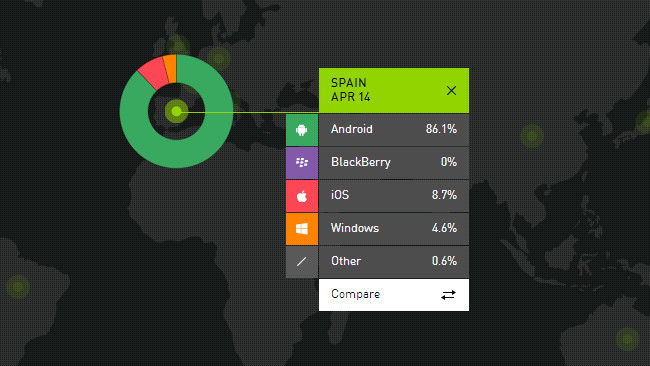
Kantar Worldpanel has released its latest report on mobile operating system sales for the last three months. Again there were mixed figures for Windows Phone, with some promising news and some causes for concern. There was stable annual growth for the Microsoft system, with a return to positive territory in Europe, although its share in the massive US and Chinese markets is dwindling. In the five main European markets (Germany, Great Britain, France, Italy and Spain) sales of devices running Windows Phone accounted for 8.4% of all smartphones sold between February and April of this year. This is a good figure, representing an increase of nearly 1.6 points against the same period 2013, and a slight 0.3 point improvement against the numbers posted by Kantar en April. The story is similar in each of the countries. In Spain annual sales of Windows Phone devices grew from 1.7% last year to 4.6% at present, with growth also recovering compared to last month. The trend was similar in Germany, UK and France. In Italy, however, there was growth compared to last year but the rate of monthly decline remains a concern, falling from 17.1% of sales in the final quarter of 2013 to 11.8%.
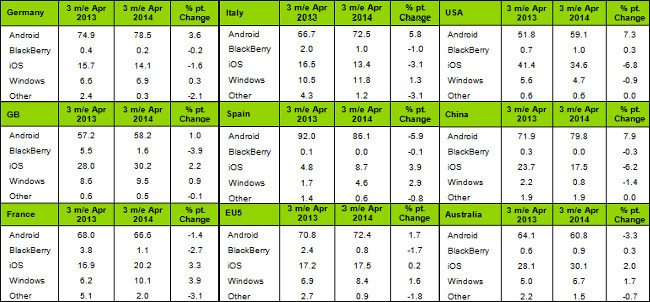
These figures suggest the system continues to grow in Europe, but the news is nuanced. The problem is that Windows Phone is yet to recover the position that it held at the end of last year, when it managed to account for 10% of smartphone sales on the old continent. The mobile system from the Redmond-based firm is still picking up market share lost by BlackBerry and other systems, of which few will remain in the near future. We will then have to see how it performs against Android and iOS, which continue to hold their ground. The markets where Windows Phone has really failed to gain traction are the United States and China. Microsoft has a serious problem in its own country, where the system represents less than 5% of smartphone sales, with its position shrinking compared to last year and last month. The situation is even worse in the Asian country, accounting for just 0.8% of sales and shrinking. In this regard, the numbers look far from promising for Windows Phone: it is failing to grow in key markets, and only recording unstable, snail's pace growth in others. But the numbers need to be couched within their proper context. Over the last few months Microsoft has been immersed in the process of acquiring Nokia, which has undermined the performance of the Lumia cell phone range. This has evidently hurt the figures for a platform that recorded 90% of its sales via the Finnish manufacturer. Having said this, Microsoft still has a huge job ahead of itself and it is far from certain that it will be able to revive the fortunes of its mobile system. The Redmond firm is readying to launch its brand new Windows Phone 8.1 system, having scrapped licensing barriers and convincing more manufacturers to join the cause. All of which should drive up direct sales of devices running Windows Phone. The next few months represent a real opportunity for the company, and one that may be its last.
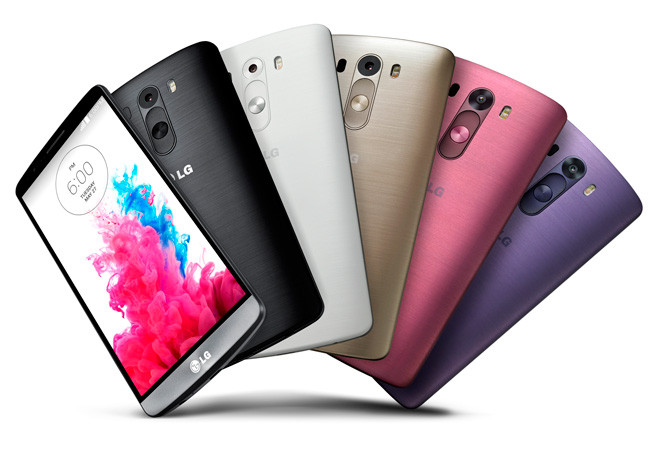
It hasn't always been one of the most media-savvy firms, but LG's return to the high-end cell phone market made a real splash. The LG G2 was a real candidate for smartphone of the year; in fact, as far as I'm concerned it was, alongside the Nexus 5. This afternoon in London the South Korean firm will be unveiling its new flagship device for 2014: the LG G3. The smartphone hopes to combine leading hardware with a similar design to last year's model, but this time around the phone is far more elegant and easy on the eye. While LG has been a bit slower to move than its main competitors, that should not be an issue as it has one key factor in its favor, and one that the firm will hope catches the market's eye. Let's see what the new LG G3 has in store. Last year LG made its mark by providing a screen that made optimal use of the front space. The frame is incredibly thin, in a smartphone with dimensions of 146.3 x 74.6 x 9.1 millimeters and weighing 151 grams. The 5.5 inch screen, representing 76.4% of the frontal space, marks it out as closer to the phablet format than a large screen smartphone. As in the last generation of phones, LG has placed buttons on the rear casing. These have been stylized to suit the new esthetic that the Korean firm wants for its flagship phone. The buttons are discrete and fit snugly within the casing. The body of the phone is made from plastic with a metallic finish. The initial photos suggested that LG would go further in this regard, but in the end it seems to have held back. Available in five colors (silver, black, gold, lilac and pink) all we now need to see is how it looks in the hand. The LG G2 casts a long shadow, and despite being quite a large smartphone it did feel very comfortable to use. We only hope this new generation will be a bit more robust, as the G2 was particularly vulnerable to knocks because of its narrow frames. On the inside there are few surprises in the combination of processor and RAM: a Qualcomm Snapdragon 801 with 2GB of RAM, which promises excellent performance. The internal memory is 16GB but can be extended to 2TB with microSD cards, although for the time being users will have to make do with the 128 available on the market. LG phones aren't the first to feature QHD screens, but they have had the most success popularizing this display and resolution, which is far superior to the small Vivo and its Xplay 3S. 2,560 x 1440 pixels over 5.5 inches means 538 pixels per inch, which sounds very good and plenty of users will be looking forward to seeing what it can do. Apart from how it looks, the touch sensitivity and colors, there is one concern that users may have regarding the new resolution: the battery. The 3,000 mAh battery should be enough for a full day of intense use without users having to worry about carrying external batteries or phone chargers around with them. LG says its decision to change the metal cathode battery for a graphite one has extended the battery life. The good news is that the battery is removable, which is refreshing in a market where batteries are increasingly sealed in. The other nice surprise from the new LG G3 is its camera. With a 13 megapixel OIS+ sensor (the same technology used in the G Pro 2), the camera offers slightly sharper focus than the G2, and features a laser system for faster focusing. A laser beam measures distance between the object and the cell phone to calculate focus distance. This promises good results in poor light. We will have to see how it performs. LG says it's fast, but the competition is sure to put up a fight. Shooting 4K video is another interesting extra, but one that has no particular market draw, even though videos should look fantastic, on the G3 screen at least. The front 2.1 megapixel camera is perfect for selfies and video-calls. In fact, LG is hoping that selfies will really help make its front camera stand out. The angle of vision has been extended to create a larger image field. A special mode has also been added that lets users start a photo timer with a simple hand movement. One of the most common criticisms aimed at the LG G2 was the software skin: the esthetic jarred with the style that Google sought to impose with Android, which coupled with fairly unstable performance and unnecessary functions to render the device somewhat clumsy to use. This year it seems LG has opted to embrace the Google design and simplify its interface with a cleaner appearance. The Korean firm has added a number of applications, such as a notepad that can also be used as a floating window. One of the key new features in this generation of LG products is that the device can learn the user's phone habits. Two applications are now available as a result: a keyboard that observes how you write and improves the accuracy of predictive text, and an assistant called Smart Notice that notifies users when several unused applications are open at once or provides contextual information. For example: in bad weather the phone may remind you to take an umbrella out with you. There are also new security features. Users can unlock their phone by tapping a Knock Code on the device. This was demonstrated at Mobile World Congress and looks good. There is also now the option to remotely format the device in case of loss, or to prevent certain files and applications from being viewed by anyone who might get their hands on your phone. The LG G3 is available for €599, cheaper than other flagship devices at launch. For those who can't wait until after the summer, when prices should come down, here is a link where you can buy the phone: Buy LG G3 for €599 on Amazon.es. This is the 16GB model, with 2GB of RAM and comes in titanium gray. There are no plans to release the Korean model, featuring more storage and RAM, in Spain for the time being.
The Cupertino-based company has updated a section of its website, where it posts official presentations, to include live streaming of the keynote address at the forthcoming Apple Worldwide Developers Conference, WWDC 2014. The event takes place on Monday June 2 at 7 pm Spanish time, with the firm expected to unveil iOS 8 and OS X 10.10 along with some new hardware.
Spotify has been the victim of unauthorized access to its internal systems and data. It seems a hacker managed to get hold of one Spotify user's information, but not their password, bank or payment details. Spotify says it's taking every precaution to prevent a repetition of the breach. One of the first things Spotify did to boost security concerned its Android application. Instead of launching a patch for any security gaps, the company chose to launch an entire new official application that users need to download from Google Play. iOS and Windows Phone users are not required take action as yet. The company has updated its previous official Spotify for Android application, but only to prevent it from working and to notify users that they need to download another application. The new Spotify application is identical to the recently revamped version. When installing the new application a cleanup service automatically opens and completely wipes the previous version from your device, with the only inconvenience being you have to synchronize any offline listening albums and playlists again.
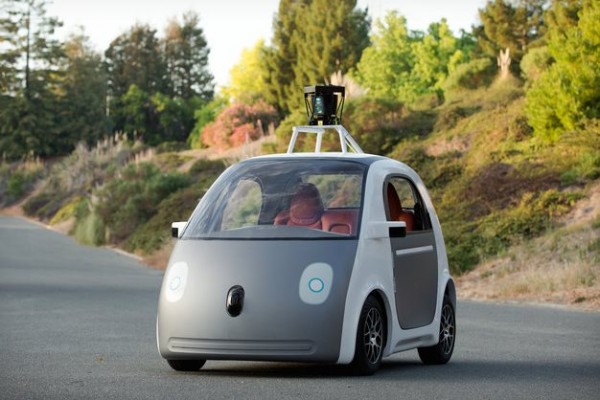
Pictured above is the latest creation from the Google X division, a research and development lab that runs in parallel the company's core business, working on projects such as smart contact lenses, fiber optics, smart clothing, etc. The car has no steering wheel, pedals or brakes and in fact steers itself, as you can see in this video. It was unveiled by Sergey Brin at the Code Conference as a functional prototype, which Google hopes will improve life for a whole swathe of the population. Using computers and external sensors, Google plans to build around 100 units this summer, although the first cars off the production line will feature manual controls just in case of problems, as the company says in its official blog. The vehicle has sensors that eliminate blind spots and can detect objects from more than two football fields away in all directions, which is important on busy streets that have plenty of intersections. The vehicle's top speed is a modest 40 km/h, it has two seats (with safety belts), a space for passengers' personal belongings, start and stop buttons and a screen that shows the vehicle's route. The project already has a Google Plus page to cover its progress, with real-world tests due to take place on the streets of California in a couple of years.
Real time translation systems are set to take a giant leap when Skype and Microsoft launch the project unveiled at the Code conference. No matter what language you speak, or in which you are spoken to, Skype will recognize it and translate it in real time. The head of Skype and Lync at Microsoft, Gurdeep Singh Pall, demonstrated the translation system in operation. Two people held a video call, each in their own language, and Skype translated the words in subtitles and also reproduced a synthetic voice translation. The system is not instant, but is fast enough to allow for a fluid conversation. When will the feature be available? The system is some way off still. Later in the year a closed beta version will be launched, while no further details have been released on what the next steps will be or which languages will be supported. We will probably hear more toward the end of the year. What is clear is that the system is a joint development between Skype, Bing and Microsoft Research Lab, using recognition technology shared with the Cortana assistant service. We can expect to see it first as part of the Windows operating system.
It could not have come at a better time. Telegram has been quick to capitalize on WhatsApp's problems - after the app was withdrawn some days ago and is yet to show signs of life-, by bringing out its big guns on the Windows Phone applications store. Several unofficial apps had been circulating for a while, which allowed the system to be used on Windows Phone, but Telegram was yet to make the official leap. All of that changed today, after it bought up one of the most popular clients (Ngram) and renamed it Telegram Messenger Beta in the app store. The messaging platform has thus established itself as a permanent piece of the Microsoft mobile ecosystem, being compatible with the versions 7.5, 8 and 8.1 of WP.
In late February Mozilla announced that it intended to launch a device aimed at developers. The device, baptized Flame, can now be reserved at a price of 170 dollars. It will be manufactured by Thundersoft together with Mozilla. The mid-range specifications will seek to win over Firefox OS developers by providing an official terminal designed specifically for them. One of the more interesting aspects of the phone is that, despite having 1GB of RAM, developers will have the option of adjusting the RAM to anywhere between 256MB and 1GB. The idea: to allow developers to test application performance on a range of memory configurations. The device comes with a 1.2 GHz dual-core Qualcomm Snapdragon MSM8210 processor, a 4.5 inch screen and resolution of 480 x 854 pixels, it supports 2G/3G, has 8GB storage capacity, a microSD slot, AGPS receiver, is NFC ready and supports Dual SIM. On the back is a 5 megapixel camera, with another 2 megapixel camera on the front. The battery capacity is 1,800 mAh. It's just a shame that the company did not partner with the Spanish firm Geeksphone to develop the device, as the latter is a specialist in such terminals.
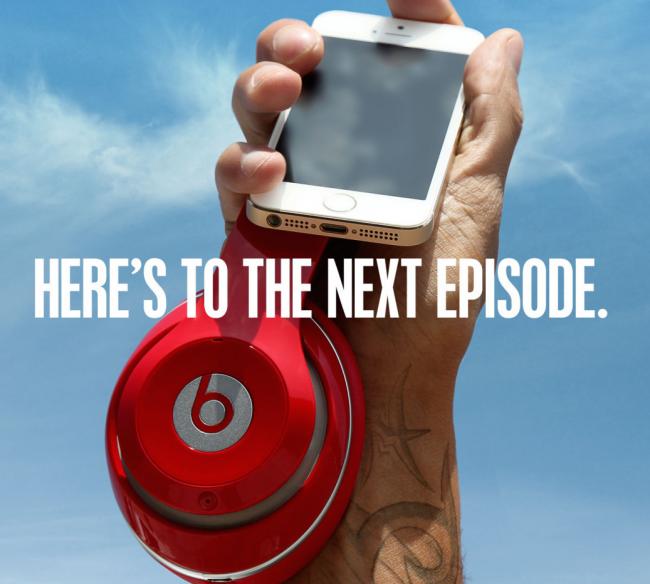
The rumor took longer than usual to be confirmed, but Beats is now part of Apple. The music company has confirmed the deal. Apple will fork out a total of 3 billion dollars on the acquisition. Included are the Beats Music service and Beats Electronics, which according to Tim Cook will be key to Apple's music strategy. Of course, he was hardly going to say anything else. One the one hand, Apple has bought Beats Music, adding a well-established service to iTunes, although it is far from a leading operator in the music streaming business. Beats Music will be linked to Apple's own iTunes Radio service. The lead that competitors had been building up over Apple was far too large for the company not take action. Secondly, Beats Electronics adds a range of music hardware accessories and products to the Apple catalog. Furthermore, beyond the quality of the products, Beats is a well-established top seller in the USA, and one that resonates with a young, premium market that is highly attractive to Apple. Cofounders Jimmy Iovine and the rapper Dr. Dre will join Apple as part of the deal, with the Beats brand remaining independent.
Late last year we forecast that 2014 would be the year of wearable devices and smartwatches, and it seems that none of the companies want to miss out on a piece of the pie, with each working on their own devices. Samsung unveiled its Gear Fit line at Mobile World Congress. While we are still waiting for Apple to launch a device, Microsoft is now working on its own smartwatch, which, unlike products from other companies, will be compatible with iOS and Android. A device 100% compatible with iOS and Android. According to Forbes, the Redmond-based company is working on a device that will be compatible with its main competitors, meaning the smartwatch will not only work with the firm's own devices but also with Android phones and iPhones, following in the footsteps of the Pebble model. The report also says the Microsoft smartwatch will be very similar in design to Samsung's Fit, with a large touchscreen across the device. It is now being developed by a number of teams at Microsoft, including the Kinect team, the cell phone division and the design department. If true, this is great news, and will put the squeeze on other devices, such as those from Samsung, that are only compatible with the firm's own mobile platform.
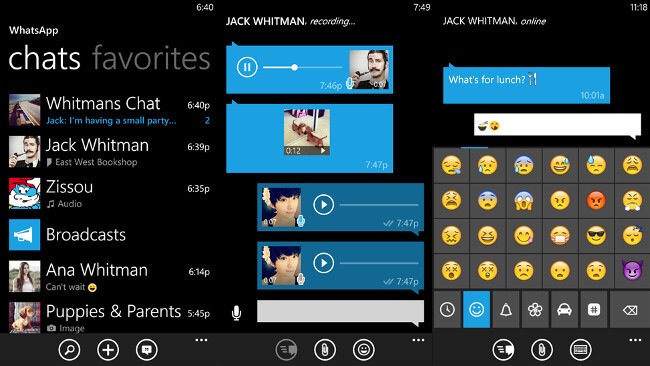
Two weeks after its sudden disappearance from the app store, WhatsApp is back on Windows Phone Store. The popular instant messaging service was forced to withdraw its application from the store due to a series of problems that affected a significant proportion of Windows Phone 8.1 users. The app has only been returned to the store in the last few hours. WhatsApp is not only back, but comes with an update that adds a number of new features. These include broadcast lists, the option to change conversation backgrounds, add personalized notification tones, change privacy settings on your account and automatically configure multimedia file downloads. WhatsApp also says it has added a number of improvements and corrected errors. The latter is important, as WhatsApp's return might suggest that its developers managed to fix the problems encountered with Windows Phone 8.1, but it seems this is not the case. Users of the latest version of the system will receive a message notifying them that some functions may not work properly. This indicates that issues may persist with notifications on Windows Phone 8.1. WhatsApp and Microsoft say they are working on fixing the bugs, but it seems they have so far been unsuccessful. The application's return may mean they have opted for the lesser of two evils and decided to simply notify users of the issue.
